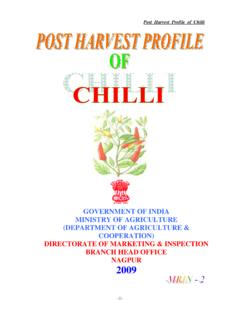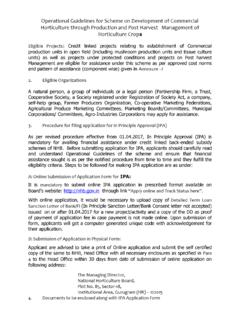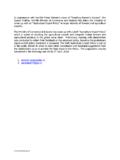Transcription of OPERATIONAL GUIDELINES 2014 - Agriculture …
1 Government of India OPERATIONAL GUIDELINES 2014 INTEGRATED SCHEME FOR AGRICULTURAL MARKETING (ISAM) Ministry of Agriculture (Department of Agriculture & Cooperation) New Delhi CONTENTS Pg. No. Chapter I Integrated Scheme for Agricultural Marketing (ISAM) 1-2 Chapter II Agricultural Marketing Infrastructure (AMI) 3-60 Chapter III Marketing Research & Information Network (MRIN) 62-73 Chapter IV Strengthening of Agmark Grading Facility (SAGF) 74-78 Chapter V Agri-business Development through Venture Capital 79-103 Assistance (VCA) and Project Development Facility (PDF)
2 Chapter VI Choudhary Charan Singh National Institute of 104-109 Agricultural Marketing (NIAM) Abbreviations 110-111 1 CHAPTER I Integrated Scheme for Agricultural Marketing (ISAM) 1. The grit and toil of farmers, dedication of agricultural scientists and consistent endeavour of policy makers have together contributed in transforming Indian Agriculture from an importer of food grain at the time of independence to a major exporter of foodgrains now.
3 However, the marketing systems and post-harvest marketing infrastructure have not been able to keep pace with the growing production and marketable surplus. This has brought to the fore, the need for providing farmers with access to competitive markets with adequate infrastructure including cold chain logistics, to enable them to realise better prices on the one hand and providing nutritious food to consumers at stable and affordable prices on the other.
4 With this objective in view, the Government of India on 13th November, 2013 approved the proposal of Department of Agriculture & Cooperation for continuation and integration of on-going Central Sector Schemes as Integrated Scheme for Agricultural Marketing (ISAM) during the XII Plan (2012-2017). The ISAM will have the following five sub schemes :- (i) Agricultural Marketing Infrastructure (AMI) [the existing schemes of Grameen Bhandaran Yojana (GBY) and Development/ Strengthening of Agricultural Marketing Infrastructure, Grading and Standardization (AMIGS) will be merged as AMI] (ii) Marketing Research and Information Network (MRIN) (iii) Strengthening of Agmark Grading Facilities (SAGF), (iv) Agri-Business Development (ABD) through Venture Capital Assistance (VCA)
5 And Project Development Facility (PDF) and (v) Choudhary Charan Singh National Institute of Agriculture Marketing (NIAM). 2. Objectives: I. To promote creation of agricultural marketing infrastructure by providing backend subsidy support to State, cooperative and private sector investments. II. To promote creation of scientific storage capacity and to promote pledge financing to increase farmers income. III. To promote Integrated Value Chains (confined up to the stage of primary processing only) to provide vertical integration of farmers with primary processors.
6 IV. To use ICT as a vehicle of extension to sensitize and orient farmers to respond to new challenges in agricultural marketing. V. To establish a nation-wide information network system for speedy collection and dissemination of market information and data on arrivals and prices for its efficient and timely utilization by farmers and other stake holders. 2 VI. To support framing of grade standards and quality certification of agricultural commodities to help farmers get better and remunerative prices for their graded produce.
7 VII. To catalyze private investment in setting up of agribusiness projects and thereby provide assured market to producers and strengthen backward linkages of agri-business projects with producers and their groups. VIII. To undertake and promote training, research, education, extension and consultancy in the agri marketing sector. 3. The overall budgetary allocation for ISAM is crores during the XII Plan. Sub scheme-wise break up of budget provision is crores for AMI, crores for MRIN, crores for SAGF, crores for ABD and crores for NIAM.
8 4. The Marketing Division in the Department of Agriculture is the overall incharge of policy formulation for the agricultural marketing sector. The Directorate of Marketing & Inspection (DMI) an attached office of the Department will implement the three sub schemes viz. Agricultural Marketing Infrastructure (AMI), Marketing Research and Information Network (MRIN) and Strengthening of Agmark Grading Facilities (SAGF); Small Farmers Agribusiness Consortium (SFAC), an autonomous organisation will implement the sub scheme ofAgri-Business Development (ABD) through Venture Capital Assistance (VCA) and Project Development Facility (PDF) and Chaudhary Charan Singh National Institute of Agriculture Marketing (NIAM), also an autonomous organisation under the Department will provide training, research and consultancy to stakeholders in the agri marketing sector.
9 5. While separate GUIDELINES have been formulated for each of the sub scheme to be implemented by the respective organisations mentioned in para 4 above, however, the Marketing Division of Department of Agriculture and Cooperation will have overarching responsibilities for the smooth implementation of the sub schemes. Towards this, Marketing Division may claim up to of the scheme funds at its level for incurring administrative expenditure towards more effective MIS, monitoring, impact assessment, hiring consultants, conducting studies, researches and any other facilitative mechanism for more effective implementation.
10 6. An Empowered Committee constituted under the chairmanship of Additional Secretary (DAC) and comprising of Joint Secretary (Marketing) / Agricultural Marketing Adviser, Director (Marketing), Joint Agricultural Marketing Adviser and Director / Deputy Secretary (Finance), IFD, DAC will resolve difficulties and smaller case to case specific decisions on implementation issues. 7. The GUIDELINES for sub scheme of Agri-Business Development to be implemented by SFAC will come into effect from All other sub schemes of ISAM will come into effect from 1st April, 2014 .







